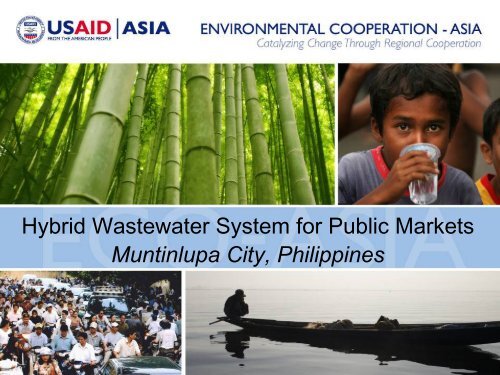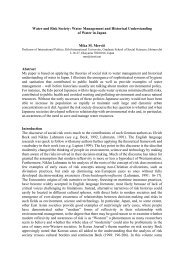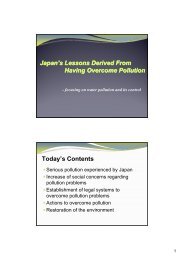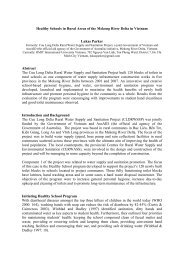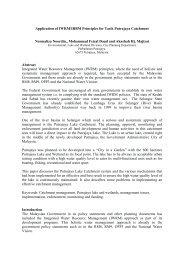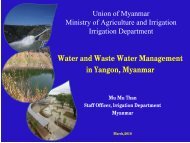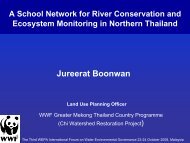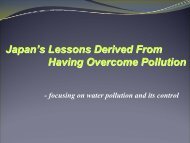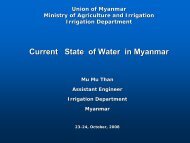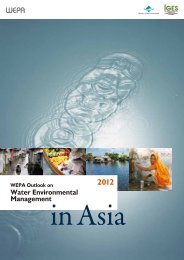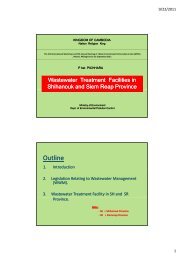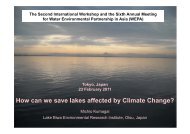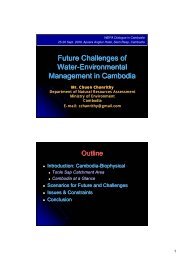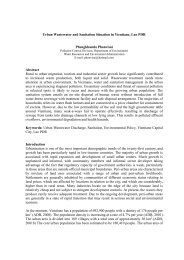Wastewater Treatment for Public Markets - WEPA
Wastewater Treatment for Public Markets - WEPA
Wastewater Treatment for Public Markets - WEPA
You also want an ePaper? Increase the reach of your titles
YUMPU automatically turns print PDFs into web optimized ePapers that Google loves.
Hybrid <strong>Wastewater</strong> System <strong>for</strong> <strong>Public</strong> <strong>Markets</strong><br />
Muntinlupa City, Philippines
LINAW Project (Local Initiatives<br />
<strong>for</strong> Af<strong>for</strong>dable <strong>Wastewater</strong><br />
<strong>Treatment</strong>)<br />
Assisting 6 Philippine cities to implement the Philippine<br />
Clean Water Act by:<br />
• Promoting the adoption of low-cost sanitation<br />
technology (<strong>for</strong> markets, slaughterhouses, hospitals,<br />
SMEs, schools, households)<br />
• Sharing innovative<br />
financing solutions<br />
• Raising public<br />
awareness
Approach<br />
to Developing Sustainable<br />
<strong>Wastewater</strong> Projects<br />
• Stakeholders - Multisector stakeholders led by local<br />
government determine priority projects<br />
• Social marketing – drive the demand <strong>for</strong> improved<br />
sanitation through innovative marketing campaign<br />
• Technology – select, design and build treatment<br />
technology based on low-cost, low energy requirements<br />
and ease of operation and maintenance<br />
• Full cost recovery – implement rules, ordinances to set<br />
user fees and penalties <strong>for</strong> non-compliance
Social Marketing<br />
Driving the Demand <strong>for</strong> <strong>Wastewater</strong> <strong>Treatment</strong><br />
“Check your septic tank or<br />
swallow the consequences”<br />
• Do market research on<br />
target audiences<br />
• Focus on behavior<br />
change<br />
• Develop messages<br />
• Pre-test materials<br />
• Launch and evaluate
<strong>Public</strong> <strong>Markets</strong><br />
Generate High-Strength <strong>Wastewater</strong><br />
<strong>Public</strong> <strong>Markets</strong> generate<br />
wastewater from:<br />
• “Wet section” stalls – meat,<br />
fish, poultry<br />
• Produce sales<br />
• <strong>Public</strong> restrooms<br />
• Prepared food area<br />
Pre-treatment devices<br />
including screens & grease<br />
traps needed to protect<br />
treatment plant
Project Info<br />
Muntinlupa <strong>Public</strong> Market<br />
• Flow: 210 cu. meters/day<br />
• Stalls: 1445 wet and dry<br />
• Influent: 600 mg/l+ BOD<br />
• Effluent discharge limit: 50<br />
mg/l BOD<br />
• Area: 160 sq. m<br />
• Timeframe: 7 months
Technology Selection<br />
Technology Capital Cost O&M/Month<br />
Land<br />
Requirements<br />
Remarks<br />
ABR/SBR Hybrid $140,000 $500 150 sq. meters Selected<br />
Lagoon $80,000 $175 2000 sq. meters Too large<br />
Constructed<br />
Wetlands<br />
$120,000 $175 1500 sq. meters Too large<br />
Activated Sludge $200,000 $700 150 sq. meters<br />
Trickling Filter $200,000 $700 150 sq. meters<br />
High cost and<br />
couldn’t keep<br />
parking lot<br />
High cost and<br />
couldn’t keep<br />
parking lot
<strong>Treatment</strong> Steps<br />
• Raw wastewater pumping<br />
• Anaerobic Baffled Reactor<br />
• Sequencing Batch Reactor<br />
• Media Filtration System<br />
• Liquid Chlorine Disinfection<br />
• Chlorine Contact and Reuse<br />
Water Holding Tank<br />
• Experimental Cocopeat Media<br />
Filtration System
Plant Layout Schematic<br />
COCOPEAT BIOFILTER<br />
IRRIGATION/PLANT BOX<br />
TOILETS<br />
ANAEROBIC BAFFLED<br />
REACTOR + UPFLOW<br />
FILTER<br />
AERATION<br />
TANK<br />
(SBR)<br />
CLARIFIER<br />
WET<br />
SECTION OF MARKET<br />
& FOOD AREA<br />
DISINFECTION<br />
CHAMBER<br />
DISCHARGE<br />
(Alabang River)<br />
MULTI-MEDIA<br />
FILTER<br />
RE-USE<br />
* Street<br />
Cleaning<br />
* Fire<br />
* Toilets
Anaerobic <strong>Treatment</strong> Process<br />
(Anaerobic Baffled Reactor)<br />
Pre-treated<br />
influent<br />
upflow<br />
chamber<br />
solid media<br />
(plasitc<br />
(beverage crates)<br />
Vertical baffles<br />
effluent<br />
gutter<br />
gas/liquid/solids<br />
phase separator<br />
settling zone<br />
granular<br />
sludge<br />
bed<br />
sludge blanket<br />
downflow<br />
chamber<br />
Baffled Module<br />
UASB Module<br />
Advantages: Small footprint, no electricity required, relatively<br />
low cost and easy to operate and maintain.
Plan View – Hybrid system<br />
System includes settling and flow equalization basin,<br />
anaerobic treatment, aerobic treatment, clarification<br />
and effluent pumping station, all in one tank
Cross-sectional View<br />
<strong>Treatment</strong> system installed completely<br />
underground so there is no loss of parking lot<br />
and delivery area
Influent and Effluent Baffles<br />
and Flow Control Structures
Tank Lid Under Construction<br />
Tank lid designed by<br />
structural engineer:<br />
• Total thickness 8”<br />
(17.6 cm)<br />
• Concrete - 3,500 PSI<br />
• Rebar- ¾” (1.65 cm)<br />
Designed to withstand<br />
the weight of jeeps and<br />
delivery trucks
Control Panel<br />
Controls:<br />
• Raw wastewater<br />
pumping station<br />
• Air blower <strong>for</strong><br />
SBR<br />
• SBR controls <strong>for</strong><br />
settling and<br />
decanting
Lamella Clarifier<br />
• Uses gravity to<br />
remove suspended<br />
solids<br />
• 90% less space then<br />
settling basin<br />
• As solids hit the<br />
plates, energy loss<br />
causes rapid settling
Air Blower – The Heart of<br />
the SBR System<br />
• Provides atmospheric<br />
oxygen under pressure<br />
to fine bubble diffusers<br />
• Fine bubbles mean<br />
less oxygen needed to<br />
impart dissolved oxygen<br />
to water<br />
• Two alternating<br />
blowers would provide<br />
better reliability
Cocopeat Filtration System<br />
• Cocopeat is byproduct<br />
from coconut producing<br />
industry<br />
• Provides high surface<br />
area and is very resilient in<br />
wastewater environment<br />
• Timed dosing draws<br />
oxygen into the pore<br />
spaces, providing aerobic<br />
treatment and filtration
Re-use Tank<br />
• Filtered and disinfected<br />
water is pumped to a<br />
gravity holding tank<br />
• Reclaimed effluent is<br />
used <strong>for</strong> public toilet<br />
flushing and stall washing<br />
• Using reclaimed water<br />
saves on pumping costs<br />
and use of potable water<br />
obtained from deep wells
Full Cost Recovery<br />
• Cost to construct: 6.8 million pesos ($136,000)<br />
• Operational costs: 27,000 pesos/month<br />
($6,720/year)<br />
• Reuse savings: 15,000 pesos/month<br />
($3,600/year)<br />
User fee structure: 5 pesos ($.10)/stall/day.<br />
1440 stalls * $0.10/day * 365 days = $52,000/year<br />
Full cost recovery period = 3 years
Lessons Learned/Conclusions<br />
• Interest and replication have been<br />
high because many facilities face<br />
the same problems<br />
• Full cost recovery is feasible with<br />
low-cost technology and user fees<br />
• Local government leadership and<br />
ownership is key<br />
• Important to build support and<br />
willingness to pay fees using<br />
effective social marketing<br />
campaigns


